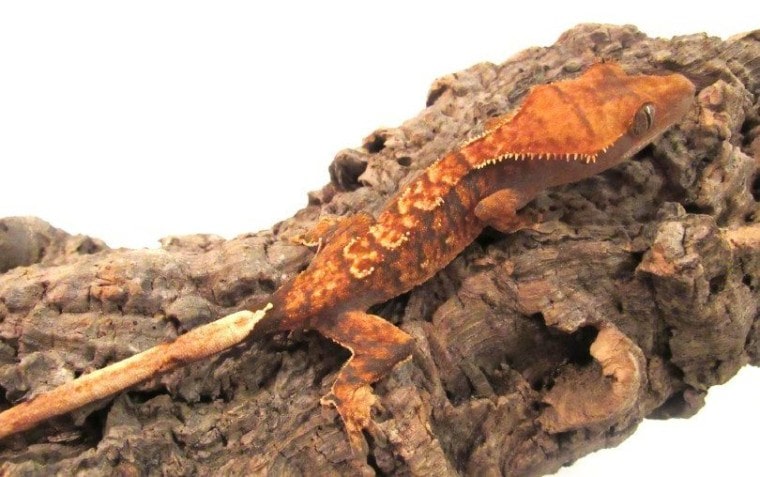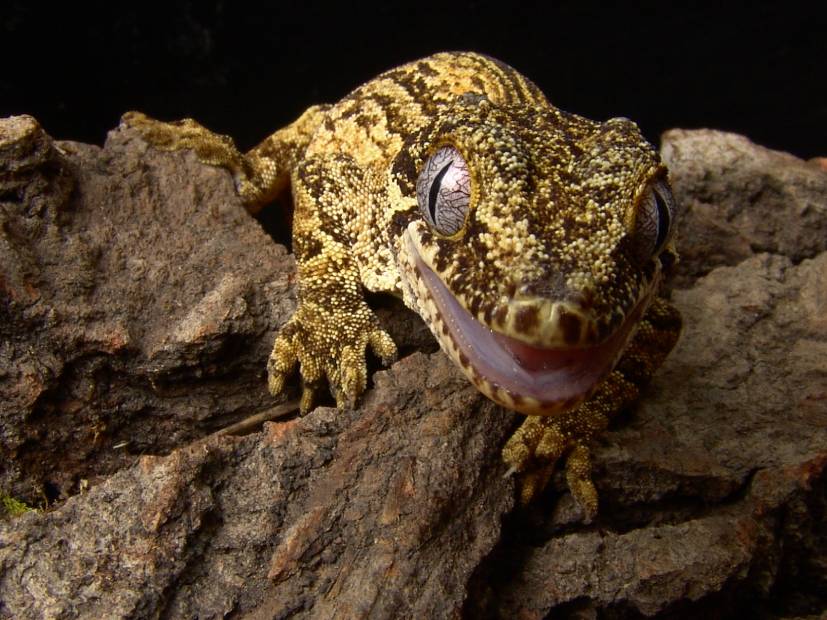
Until 1994, the crested gecko was believed to be extinct. Luckily, stable populations were hidden in New Caledonia; a small group of islands located between Fiji and Australia. Several of these specimens were used to start captive breeding Crested Geckos, and today, these lizards that were once some of the rarest kept in captivity are now relatively common. With concentrated breeding efforts, incredible new morphs and variations of the crested gecko have come about, including the eye-catching Flame morph. Exquisite in appearance but relatively simple to care for, these lizards are great choices for beginners.
Quick Facts about Flame Crested Gecko
| Species Name: | Correlophus ciliatus |
| Common Name: | Flame crested gecko |
| Care Level: | Low-moderate |
| Lifespan: | 10-20 years |
| Adult Size: | 5-8 inches |
| Diet: | Omnivore |
| Minimum Tank Size: | 20 gallons |
| Temperature & Humidity: | 70-80 degrees and 60%-80% humidity |
Do Flame Crested Geckos Make Good Pets?
In recent years, crested geckos have exploded in popularity as pets. There are many reasons for this, including their captivating and unique looks. Another major factor is the relative ease of caring for one of these lizards. Crested geckos don’t need a lot of input from their keeper. Once you get its habitat setup, caring for a flame crested gecko is quite simple.
Even better, crested geckos tend to be quite tame and relatively easy to handle. They’re rarely aggressive, and even if you do get bitten, their small mouths mean that the bite is of little consequence. Overall, flame crested geckos make excellent pets; even for first-time reptile owners.
Appearance
Flame morphs are just one variety of crested gecko. This is a unique variation that doesn’t occur naturally; it was created through planned breeding efforts. Flame crested geckos display two colors. They have a base color that makes up the largest portion of their coloration, and a contrasting second color that’s much lighter than the base color. Limbs and sides will show little to no patterning, though you might see patterns on the lizard’s top. Common Flame color combinations include red and yellow, yellow and cream, black and cream. When discussing Flame morph colors, the first color described is always the base.
How to Take Care of a Flame Crested Gecko
Habitat, Tank Conditions & Setup
The most difficult part of caring for your flame crested gecko is setting up its habitat. You’ll need to consider each of the following prior to purchasing your gecko. Once this is all set up, caring for your gecko will be simple.
Tank
You’ll need a tank that’s at least 20 gallons for a single flame crested gecko. Crested geckos are arboreal, so they do best with tall enclosures filled with branches and other climbable items. Make sure to disinfect everything before you put it into the tank to avoid contamination. Additionally, you’ll need to clean and disinfect the tank once each week with a bleach solution. The gecko will need to be moved to another tank for cleaning.
Lighting
You’ll need to replicate the sun’s cycles in your gecko’s cage. You can use a fluorescent bulb if you’re supplementing your lizard’s diet with a vitamin D3 supplement. Otherwise, it’s best to use a reptile-specific bulb that provides UVB light, even though crested geckos are nocturnal.
Heating (Temperature & Humidity)
A heat emitter bulb is the best way to keep your gecko’s tank warm. You’ll need to install thermometers in the enclosure in order to monitor temperatures. Since geckos are ectothermic, you’ll have to provide a temperature gradient in the tank, which allows your lizard to regulate its body temperature. The cool side of the tank should be about 72 degrees, but the warm side needs to be around 80. Temperatures can drop as low as 65 at night.
Crested geckos need substantial humidity to thrive. You’ll need to provide a minimum of 50% humidity, but most crested geckos will do better in higher humidity around 70%.
Substrate
Several substrates can be used effectively for crested geckos, including sphagnum moss, paper towels, newspaper, or coconut fiber. Newspaper and paper towels are easy to clean and replace, but they’re not aesthetically pleasing. Coconut fiber is fine, but some geckos will accidentally eat it when feeding, which is why sphagnum moss is the preferred substrate for crested geckos.
Tank Recommendations
| Tank Type | 20-gallon glass vivarium |
| Lighting | Fluorescent or reptile bulb |
| Heating | Ceramic heat emitter bulb |
| Best Substrate | Sphagnum moss |
 Feeding Your Flame Crested Gecko
Feeding Your Flame Crested Gecko
Flame crested geckos are omnivores that will feed on fruit and insects. However, for most crested geckos, using commercial crested gecko food is the optimal solution. You’ll still want to offer insects and fruit in addition to the crested gecko food, but a commercial meal solution will provide complete nutrition for your crested gecko.
Insects should be offered two or three times per week. Use small insects that are smaller than the distance between your gecko’s eyes. Crickets and roaches are the most popular feeder insects for crested geckos.
Fruits should also be offered to your gecko two or three times each week. Acceptable fruits include apricots, bananas, pears, peaches, and mangoes.
Diet Summary
| Fruits | 50% of diet |
| Insects | 50% of diet |
| Meat | 0% of diet |
| Supplements Required | Vitamin D3, Calcium |
Keeping Your Flame Crested Gecko Healthy
The most important aspect of your gecko’s health is its environment. If your gecko is living in poor conditions, then it won’t be able to thrive and will become highly susceptible to various illnesses. Ensure your gecko’s enclosure is the proper temperature and humidity level. Also, be sure to keep the enclosure clean, removing everything to disinfect it once per week.
Common Health Issues
Lifespan
Reptiles tend to lead rather long lives in captivity. If you provide proper conditions and adequate care, your flame crested gecko should live for at least 10 years. In captivity, most crested geckos live an average of 10-20 years, but it’s highly dependent on the quality of care the lizard receives.
Breeding
Flame crested geckos are mature enough to breed around two years of age, once they reach weights of about 40 grams. Females can have up to 16 babies in a season, laying two eggs every month of the breeding season, which can last from spring until the end of fall.
To breed your flame crested geckos, you’ll need to put a male and female in the same enclosure. You’ll see the male starting to bob its head and hear it chirping when it starts courting the female. Then, they’ll lock together for a short while, perhaps as short as a minute.
About a month after mating, the female will lay her eggs. You’ll need to incubate them for the next 70-100 days at 70-80 degrees Fahrenheit before they hatch.
Are Flame Crested Geckos Friendly? Our Handling Advice
Crested geckos are some of the most popular pet lizards in part because they’re easy to handle. These reptiles are rarely aggressive. They seldom bite, and luckily, their mouths are so small that it won’t cause any damage if it happens. If you handle your gecko regularly, it should become comfortable with handling, making it easy to hold. But don’t hold baby crested geckos. They’re so small that you can accidentally hurt them. A drop could be fatal. You also want to give your gecko a few weeks to acclimate when you first bring it home before you start handling it.
Shedding & Brumation: What to Expect
When your crested gecko is young, it will likely shed every week. As an adult, it might only shed once each month. Usually, you won’t even see it happening since these nocturnal reptiles shed at night. It takes about 15-20 minutes unless there’s a problem that impedes the shedding process.
In captivity, many crested geckos will never brumate, though they might if temperatures start to drop low enough in the winter. Brumation is a process similar to hibernation that many reptiles go through. It’s often recommended to brumate your lizards before breeding, but brumation is not necessary for a crested gecko otherwise.
How Much Does Flame Crested Gecko Cost?
As far as exotic reptile morphs go, flame-crested geckos are rather affordable. They’re only slightly more expensive than your standard crested geckos, making Flame morphs a popular choice for hobbyists. You should expect to spend about $75-$100 for a basic Flame morph, and a little bit more if you want an exotic and colorful variation.
Care Guide Summary
 Conclusion
Conclusion
Flame-crested geckos are visually captivating, yet affordably priced. They’re some of the most affordable exotic lizard morphs, and due to their relatively easy care, they make perfect pets for a first-time reptile keeper. Just make sure to keep its habitat clean and ensure that living conditions remain suitable, and you should be looking forward to 10 or even 20 years of enjoyment from your flame-crested gecko.
You may also be interested in:
Featured Image Credit: ItsJayWheeler, Shutterstock







